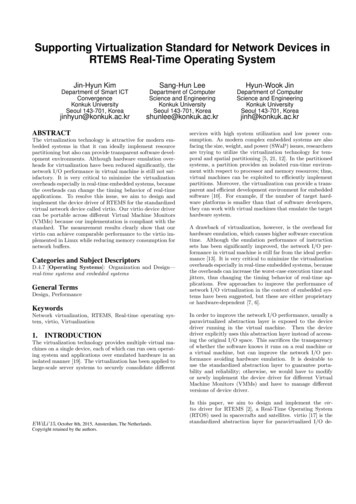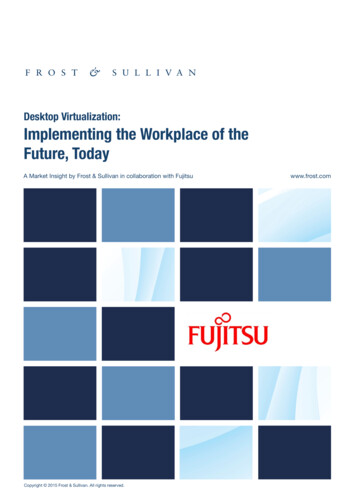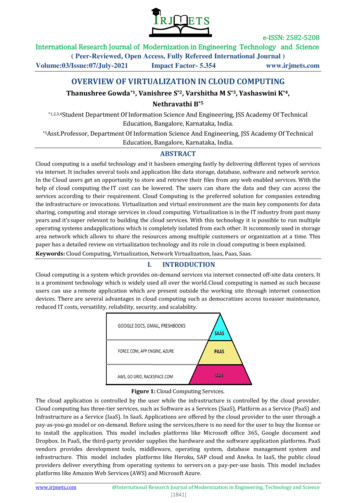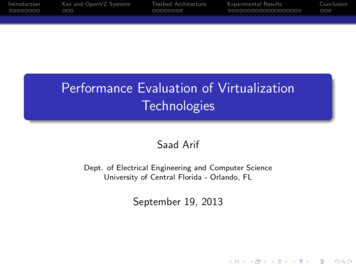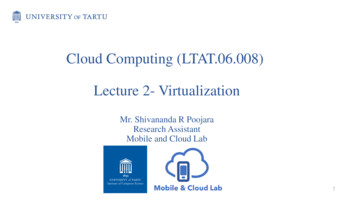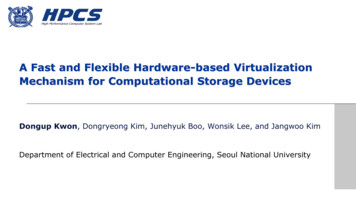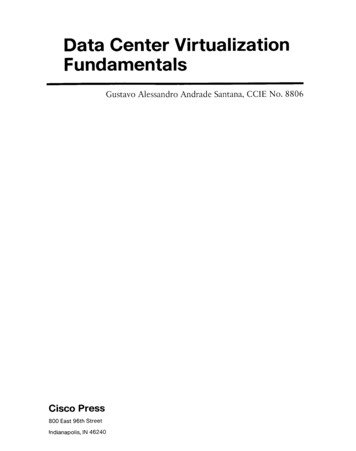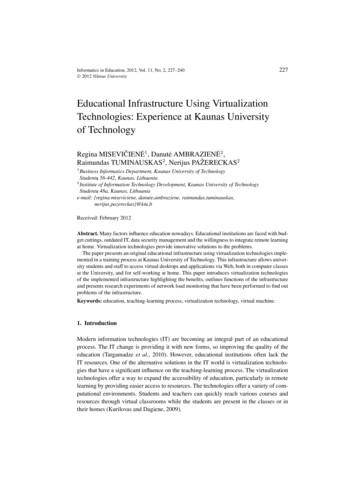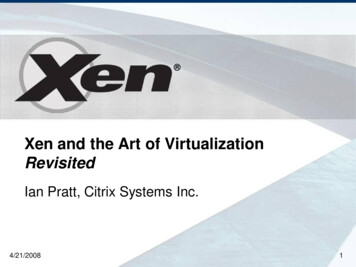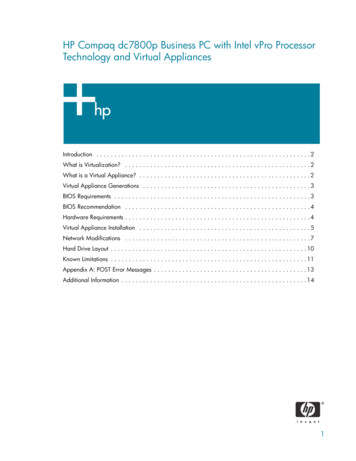
Transcription
Types of Virtualization Emulation– VM emulates/simulates complete hardware– Unmodified guest OS for a different PC can be run Bochs, VirtualPC for Mac, QEMU Full/native Virtualization– VM simulates “enough” hardware to allow an unmodifiedguest OS to be run in isolation Same hardware CPU– IBM VM family, VMWare Workstation, Parallels, Computer ScienceCS677: Distributed OSLecture 5, page 1Types of virtualization Para-virtualization–––– VM does not simulate hardwareUse special API that a modified guest OS must useHypercalls trapped by the Hypervisor and servicedXen, VMWare ESX ServerOS-level virtualization– OS allows multiple secure virtual servers to be run– Guest OS is the same as the host OS, but appears isolated apps see an isolated OS– Solaris Containers, BSD Jails, Linux Vserver Application level virtualization– Application is gives its own copy of components that are not shared (E.g., own registry files, global objects) - VE prevents conflicts– JVMComputer ScienceCS677: Distributed OSLecture 5, page 2
Server Design Issues Server Design– Iterative versus concurrent How to locate an end-point (port #)?– Well known port #– Directory service (port mapper in Unix)– Super server (inetd in Unix)Computer ScienceCS677: Distributed OSLecture 5, page 3Stateful or Stateless? Stateful server– Maintain state of connected clients– Sessions in web servers Stateless server– No state for clients Soft state– Maintain state for a limited time; discarding state does notimpact correctnessComputer ScienceCS677: Distributed OSLecture 5, page 4
Server Clusters Web applications use tiered architecture– Each tier may be optionally replicated; uses a dispatcher– Use TCP splicing or handoffsComputer ScienceCS677: Distributed OSLecture 5, page 5Case Study: PlanetLab Distributed cluster across universities– Used for experimental research by students and faculty innetworking and distributed systems Uses a virtualized architecture– Linux Vservers– Node manager per machine– Obtain a “slice” for an experiment: slice creation serviceComputer ScienceCS677: Distributed OSLecture 5, page 6
Code and Process Migration MotivationHow does migration occur?Resource migrationAgent-based systemDetails of process migrationComputer ScienceCS677: Distributed OSLecture 5, page 7Motivation Key reasons: performance and flexibility Process migration (aka strong mobility)– Improved system-wide performance – better utilization ofsystem-wide resources– Examples: Condor, DQS Code migration (aka weak mobility)– Shipment of server code to client – filling forms (reducecommunication, no need to pre-link stubs with client)– Ship parts of client application to server instead of data fromserver to client (e.g., databases)– Improve parallelism – agent-based web searchesComputer ScienceCS677: Distributed OSLecture 5, page 8
Motivation Flexibility– Dynamic configuration of distributed system– Clients don’t need preinstalled software – download on demandComputer ScienceCS677: Distributed OSLecture 5, page 9Migration models Process code seg resource seg execution seg Weak versus strong mobility– Weak transferred program starts from initial state Sender-initiated versus receiver-initiated Sender-initiated (code is with sender)– Client sending a query to database server– Client should be pre-registered Receiver-initiated– Java applets– Receiver can be anonymousComputer ScienceCS677: Distributed OSLecture 5, page 10
Who executes migrated entity? Code migration:– Execute in a separate process– [Applets] Execute in target process Process migration– Remote cloning– Migrate the processComputer ScienceCS677: Distributed OSLecture 5, page 11Models for Code Migration Alternatives for code migration.Computer ScienceCS677: Distributed OSLecture 5, page 12
Do Resources Migrate? Depends on resource to process binding– By identifier: specific web site, ftp server– By value: Java libraries– By type: printers, local devices Depends on type of “attachments”– Unattached to any node: data files– Fastened resources (can be moved only at high cost) Database, web sites– Fixed resources Local devices, communication end pointsComputer ScienceLecture 5, page 13CS677: Distributed OSResource Migration ActionsResource-to machine bindingProcess-to- By identifierresource By valuebinding By type UnattachedFastenedFixedMV (or GR)CP ( or MV, GR)RB (or GR, CP)GR (or MV)GR (or CP)RB (or GR, CP)GRGRRB (or GR)Actions to be taken with respect to the references to local resourceswhen migrating code to another machine.GR: establish global system-wide referenceMV: move the resourcesCP: copy the resourceRB: rebind process to locally available resourceComputer ScienceCS677: Distributed OSLecture 5, page 14
Migration in Heterogeneous Systems Systems can be heterogeneous (different architecture, OS)– Support only weak mobility: recompile code, no run time information– Strong mobility: recompile code segment, transfer execution segment[migration stack]– Virtual machines - interpret source (scripts) or intermediate code [Java]Computer ScienceCS677: Distributed OSLecture 5, page 15Case study: Agents Software agents– Autonomous process capable of reacting to, and initiatingchanges in its environment, possibly in collaboration– More than a “process” – can act on its own Mobile agent– Capability to move between machines– Needs support for strong mobility– Example: D’Agents (aka Agent TCL) Support for heterogeneous systems, uses interpretedlanguagesComputer ScienceCS677: Distributed OSLecture 5, page 16
Case Study: ISOS Internet scale operating system––––––Harness compute cycles of thousands of PCs on the InternetPCs owned by different individualsDonate CPU cycles/storage when not in use (pool resouces)Contact coordinator for workCoodinator: partition large parallel app into small tasksAssign compute/storage tasks to PCs Examples: Seti@home, P2P backupsComputer ScienceCS677: Distributed OSLecture 5, page 17Case study: Condor Condor: use idle cycles on workstations in a LANUsed to run lareg batch jobs, long simulationsIdle machines contact condor for workCondor assigns a waiting jobUser returns to workstation suspend job, migrateFlexible job scheduling policiesComputer ScienceCS677: Distributed OSLecture 5, page 18
Types of virtualization Para-virtualization ÐVM does not simulate hardware ÐUse special API that a modified guest OS must use ÐHypercalls trapped by the Hypervisor and serviced ÐXen, VMWare ESX Server OS-level virtualization ÐOS allows multiple secure virtual servers to be run ÐGuest OS is the same as the host OS, but appears isolated
